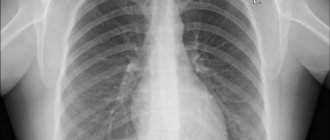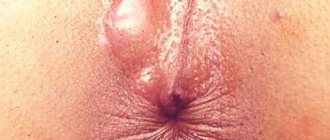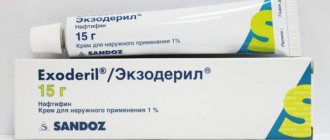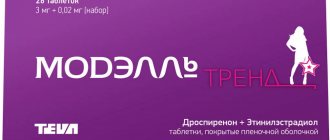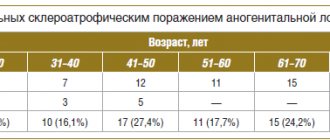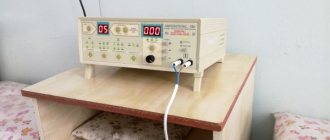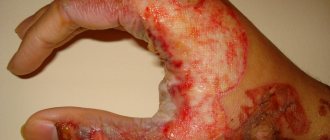Electrotherapy is the use of the properties of electric current for therapeutic purposes; it occupies a separate large section in physiotherapy. Modern methods of physiotherapy use electric current to combat various pathologies: injuries of the musculoskeletal system, diseases of the nervous system, during recovery in the postoperative period.
This article will discuss the various uses of electrotherapy in medicine, and also describe the main mechanism of its action on the human body.
Diadynamic therapy and its principle of action
Diadynamic therapy (DDT) is a method of therapeutic exposure to electric current with a frequency of 50-100 Hz.
Devices for carrying out the procedure have electrodes fixed to certain areas of the body. Electric current of different frequencies is passed through them depending on the purpose.
The electrodes are positioned transversely to the treatment area, while the cathode (electrode with a negative charge) is attached directly to the painful area. Impulses from the cathode have a more pronounced analgesic effect.
An electrode with a positive charge (anode) helps normalize tissue nutrition and restore cell conductivity.
The principle of the positive effect of DDT is based on normalizing the charge of body tissues. When pathological processes occur, the accumulation of decomposition and oxidation products of substances occurs. This leads to a disruption of the electrical charge of the tissue field. Diadynamic therapy is used to restore electrical balance.
Electrotherapy – treatment of diseases with electric current or magnetic fields
The physical ability of positive particles to move towards the negative pole and vice versa ensures accelerated circulation of blood flow and lymph, and, consequently, improvement of the entire body.
Long before the study of the influence of electric fields on the human body and the invention of power sources, ancient Greek healers used electric rays or acne to treat nervous diseases or paresis. Franklinization (on behalf of the American scientist B. Franklin) is considered the first method of physiotherapy using a constant electric field. It made it possible to improve blood circulation, lower blood pressure, accelerate wound healing, relieve pain, and significantly reduce the occurrence of allergic reactions.
Modern technology allows the use of constant or alternating pulse currents, different frequencies, different magnetic fields and their combination for treatment:
- Diseases of the central nervous system (paresis and paralysis, decreased sensitivity of the limbs, slowed passage of nerve impulses, treatment of intercostal neuralgia, neuroses, etc.).
- Treatment of diseases of the musculoskeletal system (traumatic injuries of the spine, soft tissues and/or their consequences, treatment of postural disorders, spinal curvatures, treatment of intervertebral hernias, protrusions, osteochondrosis, osteoporosis, arthritis, etc.).
- Diseases and pathologies of the cardiovascular system (thrombosis, rheumatoid arthritis, vegetative-vascular dystonia, coronary artery disease, hypertension, angina pectoris, atherosclerosis, etc.).
- treatment of headaches (migraines, tension pain, cluster and other chronic pain syndromes of the head).
- Diseases of internal organs (liver, kidneys, gastrointestinal tract, genitourinary system).
- For the fusion of epithelial tissues, treatment of skin rashes, ulcers, trophic ulcers, etc.
- In cosmetology for skin rejuvenation and removal of puffiness.
Types of physiotherapy using electricity
The most common types of physiotherapy are:
- Galvanization - direct currents of low voltage and low strength. Depending on the area of application (different parts of the body), the procedure time and dosage (tension) may vary. Activates blood flow in the extremities, restores damaged nerve fibers and soft tissues. It has an anti-inflammatory effect, relieves pain, relaxes, and relieves muscle spasms. Can be used to treat inflammatory processes of the gastrointestinal tract, hypertension, hypotension, vegetative-vascular pathologies, hearing and vision diseases. Widely used to treat diseases of the spine, spinal cord and joints.
- Electrophoresis is low-frequency electrical discharges that enhance the penetration of medications through the skin to the internal organs. The double therapeutic effect is achieved by activating blood circulation and deep absorption of drugs.
- Darsonvalization is the use of alternating pulse currents of high, ultrasonic and supersonic frequencies. It is used to relieve pain syndromes and relieve spasm of smooth muscles, increases the elasticity of the walls of blood vessels (varicose veins, trophic ulcers, long-lasting wounds), recommended for insomnia, treatment of migraines, skin rashes, frostbite, neuroses, hypertension. Widely used in cosmetology as a local procedure for tightening and rejuvenating the skin, relieving swelling and congestion.
- Electrosleep is the effect of electrical impulses on various areas of the brain. It has a calming, sedative, trophic, anticonvulsant effect. Can be used for insomnia, neurasthenia, mental attacks, ischemic attacks, asthmatic attacks.
- Diadynamic therapy is pulsed exposure to direct currents of a constant frequency (50 Hz and 100 Hz) alternating periods. Causes a sensation of tingling, slight burning, warmth or vibration. It is used to treat injuries and bruises of the limbs and spine, arthritis, treatment of osteoporosis, thrombophlebitis and other diseases.
- Diathermy is the use of high frequency, low voltage, high power currents. There is a feeling of strong heating of the skin, then deep heating of the internal tissues. Improves blood circulation, enhances metabolic processes, increases the body's immune resistance. Indicated for chronic inflammatory processes, pain syndromes (tonsillitis, rhinitis, etc.).
- Amplipulse therapy is the use of modulated sinusoidal currents for the treatment of asthma and bronchitis, inflammation of the gastrointestinal system, pelvic organs, ligaments and joints.
- Inductothermy is the use of a high-frequency magnetic field with induced eddy currents. A more uniform distribution of currents promotes uniform heating of internal organs, better tolerance by the patient and has a more lasting therapeutic effect.
Electrotherapy devices
Modern medical technicians and specialized companies offer a huge selection of devices of various sizes, characteristics and parameters for use both in medical institutions and at home. For electrophoresis and galvanization in physical rooms and at home, the following devices can be used: “Potok 1”, “ESMA 12.19 Lotus” or “ESMA 12.21U Galant”. "Aesculapius 2", "BTL 4000", "BTL 4000 Plus" allows you to generate pulses of various frequencies with a wide range. A much more expensive and functional device with a wide selection of programs, including electrosleep - “Radius - 01FT”.
A wide range of physiotherapy, magnetic and electrotherapy for the treatment of diseases of the nervous system, diseases of the spine, curvature of posture, joints, internal and ENT organs, is offered at Dr. Bobyr’s clinic in Moscow or Zelenograd.
Contraindications for electrotherapy
Despite the positive impact and effectiveness of electrical procedures for improving the health of the human body, their use must be monitored by experienced doctors and used with great caution. Electro- and magnetic therapy is strictly contraindicated for pregnant women and patients:
- with tumor formations of various etiologies;
- those who have had a stroke or heart attack or suffer from heart defects;
- with high temperature or fever;
- having purulent inflammation of internal organs and tissues;
- with acute bleeding and poor blood clotting;
- with tuberculosis or other viral and infectious diseases;
- with epilepsy or prone to convulsive conditions;
- with chronic liver and kidney diseases;
- those suffering from Parkinson's disease or multiple sclerosis;
- with individual intolerance to electric current or medications used for electrical procedures.
Author: K.M.N., Academician of the Russian Academy of Medical Sciences M.A. Bobyr
The therapeutic effect of diadynamic therapy
The current acts not only in the places where the electrodes are located, but also spreads to the surrounding tissues. The fastest electric charge passes through soft tissues, because they contain water and the liquid passes current better.
Diadynamic therapy affects nerve receptors, which helps block pain impulses. The analgesic effect is also explained by the central direction: nerve impulses switch to the zone of irritation. At the same time, endorphins are released - substances that reduce pain and discomfort.
Current pulses dilate blood vessels, this improves the tone of the walls and promotes better blood movement. Additionally, they increase blood circulation due to the uniform contraction of muscle fibers under the current. Thanks to improved blood circulation, all tissues of the body receive more oxygen and nutrients, fluids flow out and swelling is relieved.
Under the influence of electric current, skeletal and smooth muscles contract, and the conductivity of neuromuscular impulses improves. Muscle contractions tone and strengthen them, which is especially important for weakened tissues.
Mechanism of action
To understand why electric current has become so widely used in medical practice, you need to understand the subtle mechanisms and principles of its influence on the body.
It affects the human body on several levels:
- Local. Covers the immediate area of application of electric current. Local blood circulation is stimulated, immunity is increased, and metabolism is accelerated.
- Reflex-segmental. Electric current during the procedure causes somatovegetative reflexes, which cause vascular and metabolic changes already at the level of internal organs (after all, as is known, internal organs have connections with certain areas of the skin, influencing which can indirectly influence the organs).
- Organismic level. The effect of electrical procedures on the body extends to the higher parts of the nervous system, then the release of biologically active substances (serotonin, histamine, norepinephrine, acetylcholine) occurs, which, carried through the bloodstream, provide the general effect of physiotherapy - strengthening the immune system, mobilizing the body's strength, accelerating recovery processes and regeneration.
According to the nature of the energy conducted to the patient, electrotherapy methods are divided into remote and contact, according to the voltage - into low-frequency currents (galvanization, electrophoresis) and high-frequency currents (darsonvalization, franklinization), according to the mode of exposure - into direct currents and alternating currents ( pulse). Below we will look at some of them in more detail.
Methods using direct currents
One of the methods of physiotherapy that uses direct electric current is galvanization. At a relatively low current (about 50 mA), the voltage reaches 80 Volts.
The skin has great resistance to current with such parameters, which is why the most significant reactions develop with this method of physiotherapy. The patient's skin under the electrodes turns red, and a burning and tingling sensation appears, which may gradually increase during the session. This occurs due to the formation of heat, changes in the usual movement of ions in the skin and the pH of the environment.
Released biologically active substances and activated enzymes increase blood flow to the application area.
Burning and tingling in the area of the procedure depend on the duration of exposure, and also intensify with increasing current strength.
Thus, direct current electrotherapy enhances lymph and blood circulation, stimulates metabolic processes, enhances the secretion of glands, and has analgesic and anti-inflammatory effects.
Electrophoresis is used more often in medical practice. Electrophoresis is the combined action of current and a certain amount of drug.
Since ions in the skin move at low speed under the influence of electrical procedures, and the resistance of the skin is high, the pharmaceutical preparation penetrates only into the upper layers of the skin, creating a depot in it.
From it, the drug slowly spreads throughout the body through the bloodstream, so you should not expect a quick effect with this procedure.
Only a few percent of the dosage of the drug used in electrophoresis ends up in the depot.
The advantages of the procedure include:
- Can be used on almost any part of the body.
- The therapeutic effect can last up to several days, as a drug depot is formed.
- The number of side effects is minimal; drugs introduced into the body in this way do not affect internal organs.
- The drug is in an active form - ionic.
Since the main effect produced by current during electrophoresis occurs directly under the electrodes, the main indication for prescribing such a physiotherapy procedure as medicinal electrophoresis is the presence of various local pathological processes. Systemic effects on the body are usually not observed, with the exception of cases of disorders of the autonomic nervous system, when even a small dose of the drug can develop a reflex systemic reaction.
Methods using pulsed currents
For pulsed currents, strength and voltage do not have constant values. It is these currents that form the basis of electrosleep - the effect on the body as a whole through the scalp. This procedure is designed to normalize the state of the central nervous system. Current is passed through closed eyelids and the mastoid area using special electrodes.
Receptors of the scalp are monotonously irritated by current; weak currents even penetrate into the subcortical-stem regions of the brain, causing normalization of central nervous system function. Since the nervous system begins to function better, its effect on other organs also changes. This is what can explain the positive effect of electrosleep in many diseases.
Diadynamic therapy is another way of using pulsed currents in medicine. It has the following properties:
- Improves local blood flow, dilates blood vessels, relieves vascular spasms.
- Stimulates metabolic processes.
- Has an analgesic effect.
This method of physiotherapy is widely used for diseases of the nervous and musculoskeletal systems.
Amplipulse therapy produces all the effects similar to diadynamic therapy not only in the superficial parts of the skin, but also in the internal organs. At certain current parameters it can cause strong muscle contraction, which is used when electrical stimulation of muscles and nerves is necessary.
Electrical stimulation is used to enhance the functioning of certain organs and systems. The most widely used is electrical stimulation of the heart, muscles and nerves.
Methods using high frequency currents and voltages
Darsonvalization is based on the use of high frequency current. The current, passing through the skin cells, expands small blood vessels and increases the intensity of blood flow in them, eliminating vascular spasms. Thus, tissue ischemia passes and the associated pain and paresthesia go away.
The therapeutic application of exposure to a high-voltage constant electric field is called franklinization.
Having a local effect, this method of physiotherapy activates metabolic processes in the scalp, brain and its membranes, and when exposed to the area of a wound or ulcer, it dilates blood vessels, lowers blood pressure, relieves spasms if present, and stimulates erythropoiesis. Franklinization is indicated for disorders of the nervous system and for poorly healing wounds.
Methods based on the effect of electric and magnetic fields
UHF therapy is the use in medicine of the effects of an ultra-high frequency electromagnetic field on certain areas of the body. Such a magnetic field has great penetrating power. It passes through the skin with subcutaneous fat, penetrates into blood vessels, joints, bones, bone marrow and other tissues.
Inductothermy is the use in medical practice of a high-frequency magnetic field that releases heat in tissues. The method is based on the generation of heat obtained from a cable close to a certain area of the body, through which a high-frequency current passes, producing an alternating magnetic field. Heat arises in the very depths of the tissues of the human body.
During this procedure, various changes occur: blood flow accelerates, blood pressure decreases, peripheral circulation, microcirculation, and rheological properties of blood improve, it has an anti-edematous effect, regeneration processes are stimulated, and blood clotting is reduced. Since the hematopoietic function of the bone marrow is stimulated, the number of red blood cells in the blood increases, accordingly, hemoglobin increases, and the ability of leukocytes to capture (phagocytosis) increases. The immune system is also strengthened, muscle performance increases, and a calming effect appears.
Stages of the procedure
Diadynamic therapy includes the following main points:
- The procedure can be performed in a lying or sitting position, depending on the location of the areas to be treated.
- The specialist performing the procedure attaches the electrodes to certain areas of the body and sets the parameters of the current - strength, frequency, voltage, and also sets the duration of action.
The electrodes are not attached directly to the skin. They are insulated with oilcloth. Sponge pads can also be used, which are pre-moistened in warm water and squeezed thoroughly.
- As prescribed by a doctor, diadynamic therapy can be supplemented with the application of certain medications. Exposure to current improves their absorption and penetration into the deep layers of skin and muscles.
- The standard is one procedure per day lasting 20 minutes. Depending on the severity of the condition, a repeat session is allowed at intervals of 3-4 hours.
- The course of treatment consists of 10 procedures. If necessary, the cycle is repeated after 2-3 weeks.
Electrotherapy: types and indications
Home → Useful information → Electrotherapy: types and indications
There is information according to which even ancient people used the electric field for medicinal purposes. They were used to treat paralysis, nervous and rheumatic diseases.
They received electrical discharges from amber, electric fish and other creatures.
In the second half of the 18th century, the galvanic element was invented and the widespread use of electrotherapy in medicine began, which was improved every year, based on the principles of the physiology of the human body and the laws of electromagnetic fields.
Electrotherapy is a currently widely used type of physiotherapeutic treatment that involves influencing organs and tissues through an electromagnetic field or electric current. This procedure is effective in combating various pathologies and is both a primary and an additional method of therapy.
| Injurymap Flickr |
Therapeutic effects of electrotherapy procedures:
- local, covering a specific affected area;
- reflex-segmental - through electric current, somatovegetative reflexes are evoked that regulate the activity of internal organs, blood vessels, glands, smooth muscles;
- a general effect that improves the processes of recovery and regeneration with the mobilization of vitality and strengthening of the immune system.
Classification of electrotherapy methods:
- By mode of exposure: constant and alternating pulse currents.
- By voltage value: currents with high and low frequencies.
- By the nature of energy: contact procedures and remote ones.
Types of electrotherapy procedures
Physiotherapeutic methods of electrotherapy include over a dozen different procedures based on the action of electric and electromagnetic fields on the cells and tissues of the body.
Indications
Diadynamic therapy is used as one of the methods of physiotherapy to treat a wide range of diseases.
- Traumatic injuries - bruises, fractures, dislocations, etc.;
- Hypertension;
- Bronchial asthma;
- Diseases of the joints and spine - osteochondrosis, arthrosis, arthritis, etc.;
- Pain syndrome of various origins - myalgia, migraine;
- Muscle weakness;
- Inflammation of the nerves - neuralgia, neuritis;
- Metabolic disease;
- Diseases of the gastrointestinal tract - gastritis, duodenitis, peptic ulcer;
- Diseases of the upper respiratory tract and bronchi;
- Diseases of the genitourinary organs - pyelonephritis, gynecological diseases.
Effect of physiotherapy
Physiotherapeutic procedures have a normalizing effect on metabolism, redox processes, regulation of internal organs, lymph and blood circulation. In addition, they mobilize the body's defenses.
Physiotherapy is part of the comprehensive treatment of diseases. As a rule, its methods are used at the stage of remission, but can also be used in the acute stage. The main advantage of this direction is the absence of exposure to drugs and chemicals. Thus, the high effectiveness of physiotherapy is combined with the safety of its use.
Contraindications
Electrical treatment is not carried out in the following cases:
- Pregnancy;
- Exacerbation of inflammatory processes;
- Heat;
- Reduced blood clotting;
- Bleeding;
- Angina pectoris and myocardial infarction;
- Thrombophlebitis;
- Dermatitis;
- Eczema;
- Malignant diseases and suspicions of them;
- Tuberculosis;
- Damage to the skin at the sites where the electrodes are installed;
- Individual intolerance to DDT;
- Built-in metal elements, for example, fixed dentures;
Side effects
If DDT is performed correctly, side effects are rare.
When treating chronic diseases or ignoring contraindications, unpleasant symptoms may intensify and the condition may worsen.
Skin irritation and intolerance to this treatment method may also occur.
To avoid side effects, it is necessary to take into account all contraindications to DDT. The patient should be informed of any unpleasant sensations during and after the session.
Indications for using pulsed current
In the treatment of various types of pathologies, doctors use pulsed current. The impact is carried out in a rhythm specified by a special device, which corresponds to the rhythm of the functioning of the internal system or a specific organ. The pulse frequency may also change.
Pulsed currents in physiotherapy are used to treat the following diseases and pathological manifestations:
- Lesions of the neuromuscular system;
- Diabetes;
- Painful sensations of various origins;
- Obesity;
- Hyperthyroidism;
- Pathologies in the endocrine system;
- Impaired intestinal motility;
- Diseases of the genitourinary system and pelvic organs;
- Skin problems of a cosmetic nature.
Indications for the use of pulsed current may include injuries and diseases of soft tissues: bruises, myositis, sprained muscles and ligaments. This technique is used for damage to the spine and joints, as well as peripheral nerves as a result of disease or injury. The effect of current helps to cope with rhinitis, otitis, sinusitis, remove stones from the ureter, and cure lymphatic edema of the lower extremities.
In dentistry, fluctuating currents are used to treat neuralgia of the glossopharyngeal, trigeminal and other nerves, alveolitis, periodontal disease, arthritis of the temporomandibular joint, inflammatory and purulent processes in the submandibular and maxillofacial areas, including after surgery.
Types of physiotherapy with pulsed current
The physiotherapeutic procedure itself, associated with the influence of pulsed current, is an effect alternating with rest phases. The amplitude and rhythm of the current gradually increase, reach a high point, and then smoothly decrease to zero.
The current pulse is supplied through electrodes that are placed at certain points on the patient's body. The impact of the current is calculated so that the doctor can visually observe muscle contraction. In this case, the impact should not cause any discomfort. The current strength is usually 10-15 mA, the procedure lasts 15 or 30 minutes. As a rule, 15-20 such procedures are prescribed.
Pulsed currents are used in various types of physiotherapy. These include:
- Electrosleep;
- Diadynamic therapy;
- Interference;
- Amplipulse therapy;
- Electrical stimulation;
- Fluctuarization.
During electrical sleep, portions of low-intensity current pulses affect the brain receptors, normalizing the functions of the central nervous system. In this case, the pulse frequency varies from 1 to 150 Hz, and the duration is 0.2-0.3 ms. Bifurcated electrodes are applied to the patient's eyes and mastoid process.
To conduct diadynamic therapy, low-frequency pulses of 50-100 Hz are used. The impact can be separate or alternate between long and short periods. The epidermis resists this action, resulting in hyperemia, the walls of blood vessels dilate, and blood flow increases. The therapeutic effect of the procedure is associated with stimulation of the nervous system and muscle tissue.
Diadynamic therapy activates the circulatory system, metabolic processes are enhanced, and pain is noticeably reduced. This method is often used to treat pathologies of the musculoskeletal system and the peripheral nervous system.
Interference is the effect of low-frequency pulsed currents of 1-150 Hz of constant or variable frequency. The technique is used in the treatment of pathologies of the peripheral nervous system at subacute stages.
Amplipulse therapy is carried out with simulated sinusoidal currents of low frequency 10-150 Hz; mid-frequency currents of 2000-5000 Hz are also used. The current penetrates the skin, does not cause irritation, but has an exciting effect on muscle and nerve fibers. This type of physiotherapy is prescribed for problems with the musculoskeletal system, injuries, pathologies of the nervous system and other diseases.
Electrical stimulation is used to excite or significantly enhance the functioning of organs and systems. The most common options are stimulation of motor muscles, nervous system and cardiac activity. This type of impact helps maintain the vital activity and nutrition of muscle tissue, prevent its atrophy and strengthen it during rehabilitation or recovery after forced inactivity.
Fluctuarization is exposure to alternating currents of low frequency 10-2000 Hz, fully or partially rectified. They irritate and excite tissues, increasing the flow of lymph and blood.


